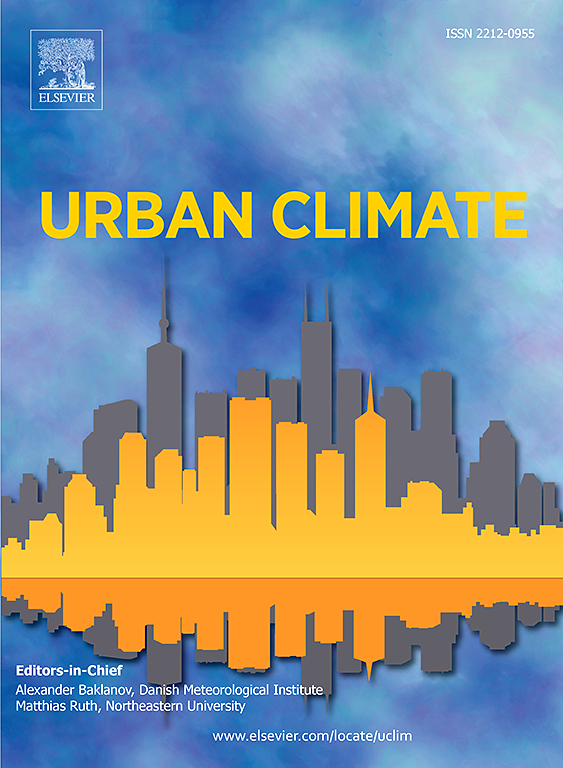里约热内卢(巴西)城市夏季极端高温和极端潮湿对健康的影响,按人口和教育水平分列
IF 6
2区 工程技术
Q1 ENVIRONMENTAL SCIENCES
引用次数: 0
摘要
背景:巴西对热相关死亡率的当地研究有限,阻碍了有针对性的热健康行动计划(HHAPs)。方法这是1997年至2019年里约热内卢大都市区(MRJ)的时间序列。利用温度-死亡率关联,调整趋势、季节性和自回归,确定了极端热事件(EHEs)的流行病学阈值(TTrh) (Box-Jenkins)。EHEs是指气温最高的夏季(DJF)。TTrh。归因死亡率(AM%)由时间控制泊松GLM模型估计。因变量为自然原因死亡率,自变量为EHE在°C中的强度(Theat)、EHE持续时间、事件等级(order)及其相应的滞后变量。亚组分析包括年龄、性别、种族和教育程度。结果TTrh为34℃(第73百分位)。RH有助于解释热量对健康的潜在影响,但它并没有提高模型的预测能力。最脆弱的群体是老年人、妇女、受教育程度较低的人以及黑人和棕色人种。最重要的ehe发生在每个季节的第一天。结论首次建立了MRJ的流行病学热浪阈值。当天气预报预报Tmax高于34°C时,应触发HHAPs。气候学方法不足以进行早期预警。预防应优先考虑妇女、社会经济地位较低的群体和老年人。虽然湿度并不能改善模型的性能,但MRJ的高湿度水平可能在热湿联合事件下构成风险,强调在未来的方案中需要考虑天气条件。本文章由计算机程序翻译,如有差异,请以英文原文为准。
Health effects of summer extreme heat and humidity in urban Rio de Janeiro (Brazil) by demographic and educational level
Background
Local studies on heat-related mortality in Brazil are limited, hindering targeted Heat-Health Action Plans (HHAPs).
Methods
This is a time series on the Metropolitan Region of Rio de Janeiro (MRJ) between 1997 and 2019. The epidemiological threshold (TTrh) for extreme heat events (EHEs) was identified using temperature-mortality associations, adjusting for trends, seasonality, and autoregression (Box-Jenkins). EHEs are those summer days (DJF) with maximum temperatures > TTrh. Attributable mortality (AM%) was estimated by time-controlled Poisson GLM models. Dependent variable was natural-cause mortality, and independent variables were EHE intensity in °C (Theat), duration of the EHE, rank of the event (order), and their corresponding lagged variables. Subgroup analyses included age, sex, race, and education.
Results
The TTrh was 34 °C (73rd percentile). RH contributes to explain the underlying effects of heat on health, but it did not improve the predictive power of the model. The most vulnerable groups were the elderly, women, less educated people, and Black and Brown. The most significant EHEs are among the first of each season.
Conclusion
This is the first study to establish an epidemiological heat wave threshold for MRJ. HHAPs should be triggered when forecasts predict Tmax above 34 °C. A climatological approach is inadequate for early warnings. Prevention should prioritize women, lower socioeconomic groups, and the elderly. Although humidity did not improve model performance, MRJ's high humidity levels may pose risks under combined heat-humidity events, highlighting the need to consider synoptic conditions in future protocols.
求助全文
通过发布文献求助,成功后即可免费获取论文全文。
去求助
来源期刊

Urban Climate
Social Sciences-Urban Studies
CiteScore
9.70
自引率
9.40%
发文量
286
期刊介绍:
Urban Climate serves the scientific and decision making communities with the publication of research on theory, science and applications relevant to understanding urban climatic conditions and change in relation to their geography and to demographic, socioeconomic, institutional, technological and environmental dynamics and global change. Targeted towards both disciplinary and interdisciplinary audiences, this journal publishes original research papers, comprehensive review articles, book reviews, and short communications on topics including, but not limited to, the following:
Urban meteorology and climate[...]
Urban environmental pollution[...]
Adaptation to global change[...]
Urban economic and social issues[...]
Research Approaches[...]
 求助内容:
求助内容: 应助结果提醒方式:
应助结果提醒方式:


